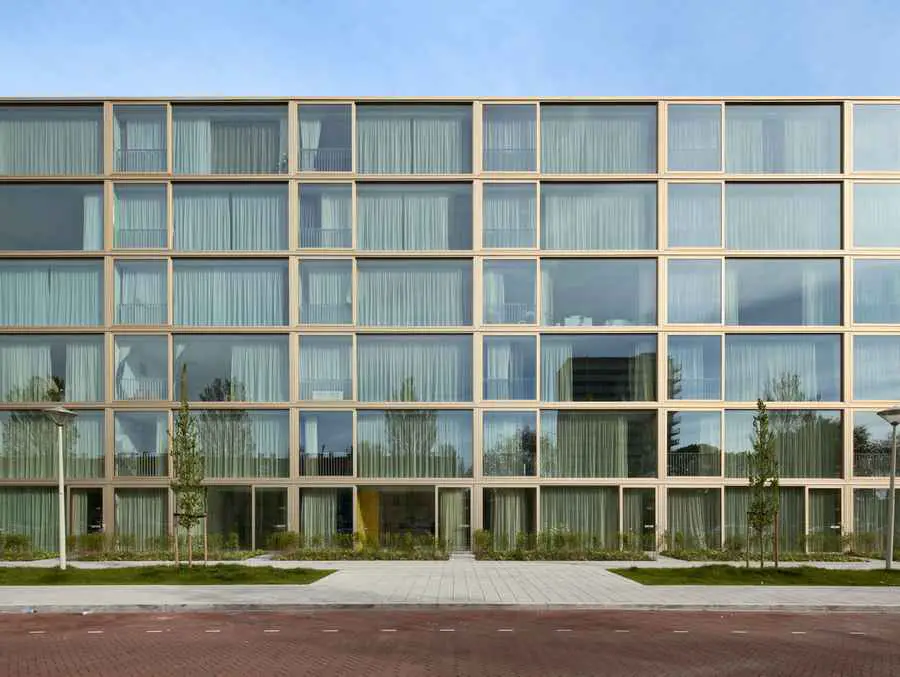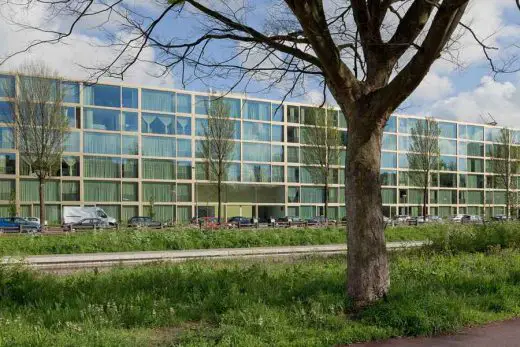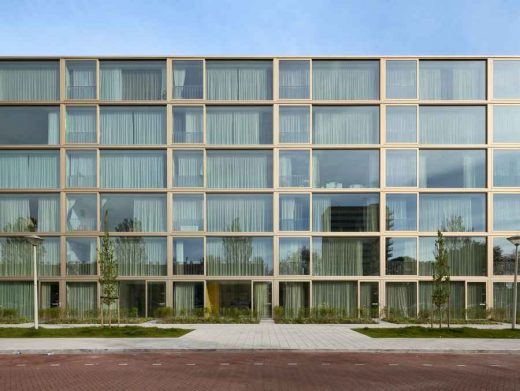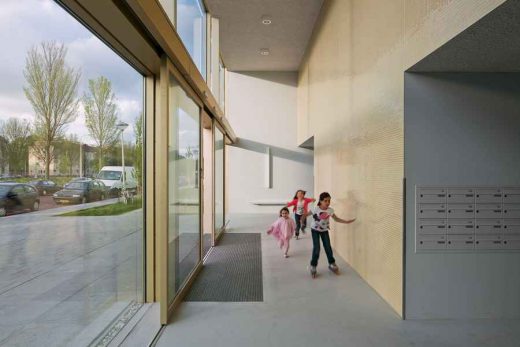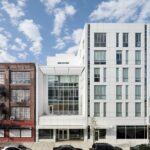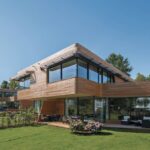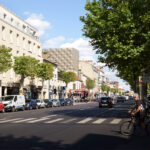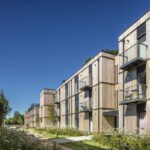Moerwijk Housing Den Haag, Dutch Residential Building, Architecture Project, Photo, Design
Moerwijk Housing, Den Haag
The Hague Residential Development, The Netherlands design by Atelier Kempe Thill
4 Sep 2012
Zilverzijde Den Haag – Moerwijk
Design: Atelier Kempe Thill, Architects
Ennobled Modernity
Block 10
Den-Haag-Moerwijk, Netherlands
2006–
The social housing project “Zilverzijde” for 88 apartments is completed along the Erasmusweg in Den Haag – Moerwijk.
Radical Tabula Rasa
In 2006, Atelier Kempe Thill is commissioned to design Block 10 in the Moerwijk neighborhood of The Hague with eighty-eight apartments and twenty-seven terraced houses as the result of a negotiation procedure by Vestia, the largest building corporation in the Netherlands.
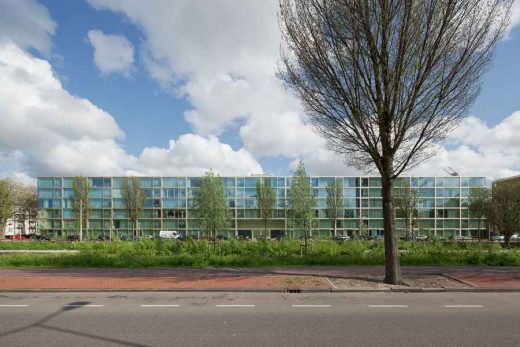
photo copyright Ulrich Schwarz, Berlin
Moerwijk is a typical restructuring area with residential buildings from the nineteen-sixties, as also exist in many large cities in the Netherlands. Also here, the city and housing corporations agreed on the comprehensive demolition of the entire area rather than renovation of the existing buildings.
Commissioned to create the new urban development plan required was the firm KCAP, whose project is fundamentally based on the existing street and block structure. What is distinguishing here—as in the majority of comparable planning situations—is the fact that it is not possible to change the street grid due to the new necessary infrastructure, as well as the fact that such a largescale operation would have to be realized in smaller steps of 150 to 250 residences.
For this reason, the new development adheres nearly exactly to the old building lots, but with a substantial difference: the depth of the buildings has been increased from nine meters to approximately thirteen, and a new mix of apartments and terraced houses is created in place of the original development, consisting exclusively of apartments. The apartments thus stand on the edge of the area and form an “urban border,” while the terraced houses are located in the more intimate interior of the grid.
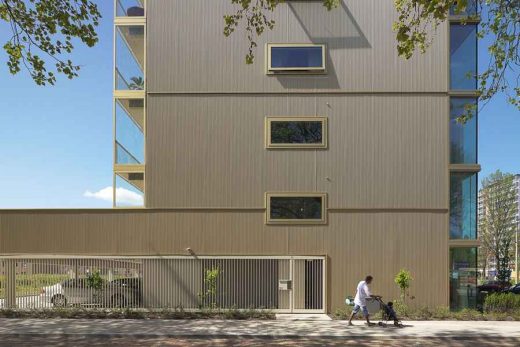
images copyright Ulrich Schwarz, Berlin
KCAP originally envisioned retaining two of the three-story apartment blocks in the heart of the area as a witness to the original urban development plan of Willem Marinus Dudok. Based upon feasibility studies conducted by the housing corporation, these last two structures were, however, also approved for demolition in the end. Suitable renovation with the combining of apartments as well as the corresponding acoustics and energy efficiency would have exceeded the maximum budget. The ground plan and the building structure were also not appropriate for the planned changes.
The impressive planting of the courtyards and the carefully composed trees on the streets (magnificently blooming ornamental species) were also sacrificed to the bulldozer, so that after fifty years everything was virtually started again from scratch on the basis of a consistent tabula rasa— and indeed with the fascination for the virgin, bare sand area that is so typical for the Netherlands, and in which one is able to dream up new buildings like a new beginning of life.
What is moreover remarkable is the economic logic of such a large-scale operation, which ultimately makes the entire current production of residential buildings in the Netherlands seem like an increase in luxury. Such an operation is only then feasible when approximately two times the amount of living space is built up once again. Finally, however, only the same number of residences as before will be built despite a doubling of the area. In addition, approximately only half the number of people will live in these new apartments compared to fifty years ago.
A Collective without Collectiveness
The new design for Block 10 is conceived by KCAP as meaning an apartment development along Erasmusweg, which is the main street leading to downtown The Hague, and also an area of terracedhouse development situated behind the apartments. The buildings along Erasmusweg serve as a noise barrier for the surrounding area to the back while also functioning as a city boundary.
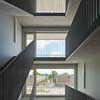
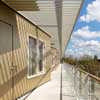

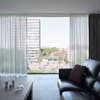
images copyright Ulrich Schwarz, Berlin
According to Atelier Kempe Thill’s analysis regarding both the required parking space and storage space for the apartments, which should also be situated on the ground floor, it becomes clear that it would be necessary to assume that the space between the two buildings would be filled completely with parking space. Building an underground parking garage would be uneconomical due to the high water table.
As an alternative (and similar to the residential building project in Amsterdam-Osdorp), Atelier Kempe Thill proposes covering the parking space with a green roof deck, which it envisiones as a terrace for neighboring apartments as well as a communal area with opportunities for children to be able to play. Generous openings in the deck are planned in order to make it possible to ventilate the garage naturally. Building such a large residential complex from scratch thus offers the chance to create a generous, collective inner courtyard.
The discussions regarding this idea that Atelier Kempe Thill conducts with the housing corporation are worth noting. It quickly becomes clear in the meetings with Vestia that the combination of terraced houses with apartments would lead to social differences between the residents, which would make any shared use of the courtyard inconceivable.
Vestia is of the opinion that second- and third-generation Turkish and Moroccan immigrants who have achieved prosperity would live in the terraced houses, that large, first generation families from Turkey and Morocco would probably live in the subsidized maisonette apartments, and that retired Dutch citizens would prefer the upper floors.
According to this assessment, none of the target groups would be interested in sharing a single courtyard with the others. The design desired is thus one that guaranteed a generous coherence optically while clearly separating the residents of the two sections spatially, since they would otherwise—according to the conjecture—only disturb each other.
Access balcony Remains Access balcony
Residential housing development in the Netherlands in the nineteen-sixties and early seventies, for instance the well-known Bijlmermeer in Amsterdam, is mostly characterized by long, anonymous balconies for accessing the individual residences. This form of access is by far the most economical since the passageway in the form of a prefabricated slab of concrete need only be suspended on the exterior of the building structure without actually being part of the isolated building structure.
Due to the anonymity of an access balcony and the fact that the residents are completely exposed to the weather before reaching the elevator or stairway, the access balcony is—especially when it is quite long—one of the main criticisms expressed with respect to the residential building architecture of late modernism. Atelier Kempe Thill begins its work on the design of the new apartment building with this awareness and proposed various two-story apartment typologies with other forms of access.
The housing corporation, however, come to the conclusion that only one-story apartments are desired. Two-story maisonette apartments need be reduced to the absolute minimum since this target group would clash with the retired Dutch residents, who must become accustomed to old age and infirmity. One-story apartments, which are per definition wheelchair-accessible, could, however, only be accessed in the given situation by means of an access balcony, which automatically results in a building typology that is nearly exactly the same as that which was so severely criticized in the sixties.
This situation was, nevertheless, accepted. In order to upgrade the access balcony socially and architecturally, Atelier Kempe Thill proposes combining the actual balconies of the apartments directly with the access by enlarging it to some extent. This combination is particularly appreciated in the case of apartments for the “55 plus” generation since it facilitates more social contact.
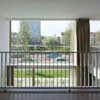
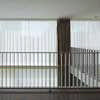
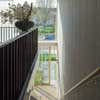
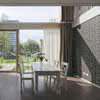
images copyright Ulrich Schwarz, Berlin
Panoramawoning or Doorzonwoning
The apartment size for the standard apartments desired by the housing corporation equates to ninetyfive square meters with two bedrooms. The dimension between construction axes that allows the apartments and the parking garage to be coordinated with each other consists of 7.2 meters. Almost all interior dimensions of the rooms, up to the positions of sinks and the like, are precisely defined by the Woonkeur certification system, which generally applies to subsidized housing construction in the Netherlands.
Within this basic plan, only two possible apartment layouts arise, quasi in autopilot: first, the doorzonwoning with the living room traversing the building with one bedroom on each façade. The second option is the panoramawoning, in which the living room completely takes up one side while the other side is occupied by the two bedrooms.
Here, Vestia decides on the panorama variant, which provides the building with a generous living room and a view of the parklike Erasmusweg with its stream. This constellation made it possible to design a glass façade for all of the living rooms that spans the complete height of the floor with 4.5-meter-wide fixed glazing and a 2.5-meter-wide sliding window. The corner apartments have been given glazing in the living room, which extends around the corner.
All of the glasswork extends somewhat over the ceilings of the floors at the top, which means that curtains can be hung in the interstice that is created. The window connections are minimized at the bottom as well as on the sides in order to achieve a comprehensive visual opening of the interior toward the outside. The bedrooms facing the side where the access balcony is located can also be provided with generous windows despite the restricted budgetary framework.
“Golden Flat”
The outer appearance of the building complex is defined by the subtle, golden “champagne” hue of all metal construction elements in the external façade, which also strives to form a connection with the atmosphere of other residential areas in The Hague. The aluminum window frames and extruded cover plates as well as the fine-ribbed corrugated sheet metal are executed in a subtle gold color.
The goal in doing so is to lend the building complex a discrete touch of nobility and to consciously break the stigma that social housing construction not only has to be cheap but also has to look cheap. This effect is particularly important on the upper façade, which due to the limited financial framework only allows for a few windows and is thus rather closed.
On the two main façades facing Erasmusweg and Wildenborghstraat respectively, the glazing dominates the façade. This gives the complex a distinctly public character toward the outside, while the bedrooms characterize the private character toward the inside. The large window glazing has a harmonious relationship to the overall size of the building, which means that its overall scale can easily be comprehended by viewers.
The detailing of the two façades represents a further development and refining of the projects in Amsterdam-Osdorp and Zwolle. This situation is particularly noteworthy since it was possible to achieve a very large reduction in sound comprising more than twenty-eight decibels as a result of the façade along Erasmusweg, a situation that reflects heightened requirements for all the profiles, connections, and the glass.
The dimensions of the glazing are even larger here than in the previous projects and the coverings between the window frames even narrower—with the goal of making the panes and thus the building as a whole appear even more generous. The coverings here are no longer flat but instead consist of extruded aluminum profiles fabricated especially for the project in order to create a tauter image in every detail. And to give the building even more lightness, the panes of the corner windows have no corner profile and are only glued.
The maisonette apartments can be accessed from the street by means of sliding doors. The mailboxes are executed in their glazing as integrated sound-insulated flaps.
It was possible to address Vestia’s concerns regarding the ease of using the lifting/sliding doors in the living rooms, whose panel weight exceeds 250 kilograms, using a model with a scale of 1:1. With this model, both the impermeability to wind and rain and the ease of operation for older individuals is tested by three potential residents.
In summary, it is possible to say with respect to the façade that within the very limited cost framework, the deviations from customary standards were only possible as a result of a consistent, Fordist manner of design with as few deviations as possible. This is based on the belief that, by concentrating on just a few details and realizing them critically with respect to all technical questions, it is possible to achieve not only convincing results but also technical innovation as well.
For mass housing projects in the Netherlands, it is by no means possible to confirm any purported economic equivalence between a “mass-customization strategy” with many individual adaptations and “Fordist consistency.” With the strategy of serial repetition, it is also much easier to address the increased risk and the reduced leeway in design that is connected with it, above all in the case of such large projects, and to counter clients’ greater aversion to risk with persuasive arguments.
The Block 10 complex moreover has a future-oriented energy concept: in addition to various standards, such as heat recovery, mechanical ventilation, and well-insulated façades with sunprotection coating, which are customary for Atelier Kempe Thill, all of the heating energy is obtained by means of a geothermal system.
1 Jul 2010
Moerwijk Housing in Den Haag
Design: Atelier Kempe Thill, Architects
English text (scroll down for German)
START BUILDING PROCESS
HOUSING BLOCK DEN HAAG – MOERWIJK/ NL
The Moerwijk housing estate – originally designed by Dudok – will be in the next years partly removed. Within the new urban plan of KCAP the housing block along the Erasmusweg will be one of the first steps of the urban renewal operation. The block consists out of a social housing flat with gallery-access apartments and maisonette housing at the ground floor and a strip of terraced houses with voids. Both buildings are connected with a parking garage at ground floor level with a semi-public deck on the top.

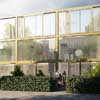
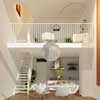
image from Atelier Kempe Thill
The houses will get specially developed aluminium facade system with jumbo glass plates (up to 3 x 6 metre) and big sliding doors. The complex will be built according to low energy standards. The block will get an own geothermal heating and a cold-heat-exchanger. All apartments have floor heating and are based on mechanical ventilation to avoid heat- loss.
Moerwijk Housing Den Haag – Building Information
Client: ceres – vestia, den haag
Program: 81 apartements (social housing) + 27 row houses (free market) + parking garage 115 cars
Location: den haag – moerwijk, the netherlands
Value: € 14 million
Status: start building process 07/2010
German text:
SPATENSTICH
WOHNBLOCK DEN HAAG – MOERWIJK / NL
Obwohl ursprünglich vom bekannten holländischen Architekten Dudok entworfen, wird das Wohngebiet Den Haag – Moerwijk in den nächsten Jahren teilweise abgerissen.
Im neuen städtebaulichen Plan von KCAP ist der Wohnblock entlang des Erasmuswegs einer der ersten Schritte zur Stadterneuerung. Der Block besteht aus einem Bauteil mit über Laubengänge erschlossenen Sozialwohnungen und Maisonettewohnungen im Erdgeschoss. Ein zweiter Gebäudetreifen beherbergt Reihenhäuser mit Wohnräumen von doppelter Geschosshöhe. Beide Gebäudeteile sind durch eine ebenerdige Parkgarage verbunden, auf deren Dach sich eine gemeinschaftliche Terrasse befindet.
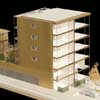
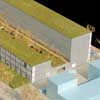
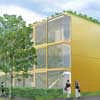
image from Atelier Kempe Thill
Für das Projekt wurde ein Aluminiumfassadensystem entwickelt mit großen Festverglasungen (bis zu 3m x 6m) und großzügigen Schiebefenstern. Der Komplex erfüllt den Niedrigenergiestandard. Der Block hat einen eigenen Wärmespeicher im Boden und verfügt über eine Geothermieanlage. Alle Wohnungen haben Fußbodenheizung und werden mechanisch be- und entlüftet, um Wärmeverluste zu vermeiden.
Moerwijk Housing – Building Information
Auftraggeber: ceres-vestia, den haag
Program: 81 Sozialwohnungen + 27 Stadthäuser + Garage für 115 Autos
Standaort: Den Haag – Moerwijk, NL
Bausumme: € 14 million
Status: start bau 07/2010
ATELIER KEMPE THILL
architects and planners
Moerwijk Housing Den Haag images / information from Atelier Kempe Thill
Location: Den Haag, The Netherlands
Architecture in Den Haag
Den Haag Buildings – Selection:
Koningin Julianaplein
Office for Metropolitan Architecture
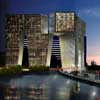
image courtesy of the Office for Metropolitan Architecture (OMA)
Koningin Julianaplein
Villa Dali, Vroondaal
123DV
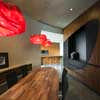
photograph : Christiaan de Bruijne
Villa Dali
Netherlands Forensic Institute, Ypenburg
Claus en Kaan Architecten
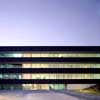
photograph : Christian Richters
Netherlands Forensic Institute
Football stadium ADO
Zwarts & Jansma Architects

photo : Rob ‘t Hart
ADO Den Haag
Station for the Randstadrail network, Beatrixlaan
Zwarts & Jansma Architects
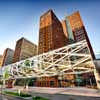
picture : DigiDaan
Randstadrail Station Beatrixlaan : Den Haag
Netherlands Forensic Institute The Hague
Comments / photos for the Moerwijk Housing Den Haag Architecture page welcome
Website: The Hague

